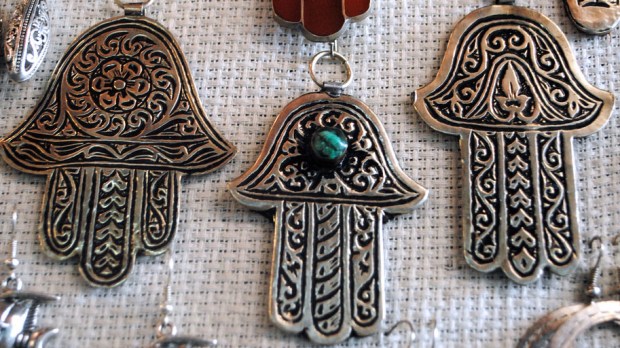Archaeological findings have revealed the use of amulets was a common practice among the ancient cultures living in biblical lands. Amulets are, broadly speaking, enchanted objects people use to protect themselves from evil and injury, while also bringing good luck, which have not stopped being popular in our own day and age. One of these, used mostly in pendants and bracelets is “the hand of Jamsa,” also known as “the hand of Fatima.”
History of this symbol
Jamsa is the word for “five,” in Arabic. The use of this talisman has been documented since ancient times. It is possible that it may have been incorporated into African and Middle Eastern Mediterranean cultures as an evocation of the known motif of “the hand of God,” which can be seen in Jewish iconography as early as 244 in the frescoes of the Synagogue of Dura Europos in Syria. It was later adopted by the Carthaginians as it was associated with the goddess Tanit, patroness of Carthage, and passed to the Berbers and the Maghrebis (also known as Roman Africans). Thus, the Jewish and Arab cultures adopted the jamsa as an outside influence.
Symbolism of “the hand of Fatima”
The jamsa is a symbol formed by a hand with five fingers, with the middle finger right in the center. Attached to the middle finger are the index finger and the ring finger, which are a little shorter than the center finger, but share the same size between them. On the sides, there are two thumbs, also of the same size, slightly inclined outwardly.
The symbol does not come directly from Islam. Although in the Koran superstition is prohibited, the five pillars of Islam are often represented by the five fingers of “the hand of Fatima.” The Jewish people have used it to represent the Pentateuch, the five books of the Torah.
This symbol can actually have more than one meaning for its adherents, depending on whether is placed upwards or downwards. Upwards, which is the original position, indicates blessing; it is also used as protection against “the evil eye”. When pointed downwards, its meaning changes since it usually includes “the eye of Fatima” – also known as the “Turkish Eye” – which is usually blue and is said to attract luck.
What does the name of Fatima mean?
Fatima az-Zahra (“the luminous one,” in Arabic) was the daughter of Muhammad, the founding prophet of Islam. She was born in Mecca on July 27, 604. It is said that her husband Ali, a cousin of the prophet, brought a concubine to his house while Fatima prepared dinner. She experienced such distress and pain in her heart, they say, that she didn’t even react to her physical pain as she cut and burned her own hand. Ali realized his mistake and devoted himself totally to Fatima, according to the story.
Use of the “hand of Fatima”
Adherents of Judaism, Islam, and some Middle Eastern Christians appear to preserve the folkloric motif of the hand known as “jamsa,” most likely as a reference to “the hand of God.” What in the past may have been used as an amulet, lucky charm or talisman today has become more an expression of a monotheistic faith by both Jews and Muslims, as a reminder of God and an expression of their desire to receive his blessings and protection.
In popular culture, jamsa is more of a decorative motif. But there are some people who confer a fetish-like and superstitious value to it, much as some people would to a horseshoe or a rabbit leg, believing that these will bring them good luck. But beyond this, the jamsa does not have a neo-pagan meaning among adherents of the monotheistic Abrahamic religions. For them, the jamsa is simply an expression of their desire to have God watch over them and bless and protect them. As a sort of “icon” all these expressions have as their ultimate reference “the hand of God.”
The use of “the hand of Fatima” as an amulet
If we feel the need for protection against evil and against demonic powers, God has something much better to offer than amulets, as we find in the Letter to the Ephesians 6: 11,14-17: “Put on the whole armor of God, so that you may be able to stand against the wiles of the devil. Stand therefore, and fasten the belt of truth around your waist, and put on the breastplate of righteousness. As shoes for your feet put on whatever will make you ready to proclaim the gospel of peace. With all of these, take the shield of faith, with which you will be able to quench all the flaming arrows of the evil one. Take the helmet of salvation, and the sword of the Spirit, which is the word of God.”
To trust in amulets is to stop trusting in the loving providence of God.

